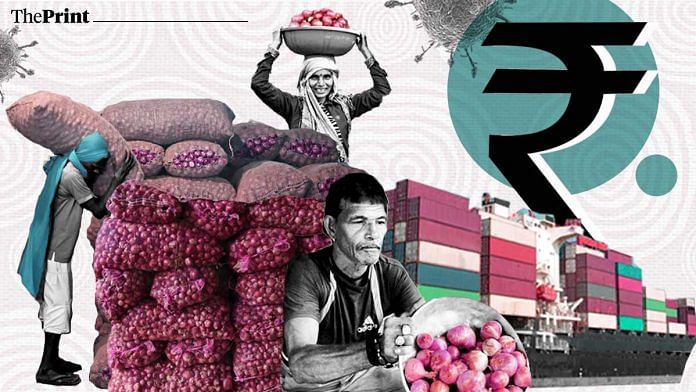The Narendra Modi government’s order banning the export of onion until March 2024 has left the farming community dissatisfied. After senior ministers from the Maharashtra Cabinet met Union Commerce Minister Piyush Goyal on Monday, the Centre has promised to buy 2 lakh metric tonnes of onions from the farmers in Maharashtra.
But this approach is hardly a solution.
Why is it bad?
Abrupt and stringent measures, like banning exports and reducing stock limits, have adversely affected farmers’ incomes. Before the ban, onions were subject to a minimum export price (MEP). This price may be higher than international prices, making international buyers unlikely to purchase. Another tool at the disposal of governments is stocking limits under the Essential Commodities Act.
The frequent and often arbitrary use of these tools to control agricultural prices has been criticised. Many researchers argue that these actions, driven by rising food prices and inflation concerns, reflect a knee-jerk approach. Between 2015 and 2020, restrictions on onion trade cost farmers 20 percent of their income. This loss does not account for losing trust and subsequent purchases from foreign buyers due to unreliable supplies.
Poor warehousing facilities due to low investments also contribute to significant loss of crops in India. Around 30 percent of onion crops go to waste post-harvest due to low-quality warehousing. However, investment in warehousing is unlikely if the government declares warehouses as illegal or limits their storage capacity.
Instead of sudden changes to trade and warehousing regulations, policymakers should focus on long-term solutions to tackle fluctuations in the prices of agricultural commodities. Attempts to adjust the market manually to stabilise prices have failed. More integration with global supply chains and better warehousing would play a significant role in price stabilisation.
A functioning futures market for agricultural commodities would also help in price predictability and help farmers make sowing decisions. While the National Commodity and Derivative Exchange (NCDEX) does exist, as pointed out by researchers at ICRIER, frequent and unpredictable changes in stocking rules and sudden suspensions of goods from the market have dissuaded traders.
Also read: Onion export ban is not the answer — it hurts farmers & India’s image as a reliable exporter
India’s trade policy framework
The Foreign Trade (Development and Regulation) Act of 1992 authorises the Indian government to regulate trade policies, including the export and import of goods. To import/export, a licence and an importer-exporter code number from the Directorate General of Foreign Trade must be obtained first. Section 3 of the Act grants the Union government complete authority to regulate the export of goods, including agricultural products.
While the FTDR Act provides a legal basis for these trade regulations, frequent and abrupt changes in trade policies, like those concerning agricultural goods, are made through executive orders. The executive has complete discretion to modify trade policies and is insulated from judicial scrutiny.
The Agriculture Export Policy 2018 states that it is essential for India to frame a stable and predictable trade policy with limited interference from the government. It cites policy uncertainty and frequent interventions as key reasons for hindering the development of stable trade relations. However, this policy is not in effect.
Also read: Ban on GM mustard harms Indian farmers. Supreme Court must choose science over ideology
The road ahead
A more thoughtful and balanced trade policy is recommended to address supply crunch and inflation concerns. This approach minimises abrupt changes, ensures transparency, and aligns policies and regulations with market needs. India can draw inspiration from the remarkable journey of New Zealand’s agricultural sector.
In the 1980s, New Zealand underwent a substantial transformation: from a heavily regulated and subsidised agriculture system to a dynamic, consumer-centric approach. In the face of economic challenges, New Zealand liberalised the agriculture sector in 1984, allowing farmers to respond directly to consumer demands. The transition involved shedding protectionist measures, which increased productivity, efficiency, and income.
New Zealand has shown that a forward-thinking approach that embraces consumer needs, encourages adaptability, and promotes resource efficiency can contribute to domestic economic stability and a more robust position in the global market.
In 1991, India liberalised its manufacturing and service sectors, which have since flourished. The agriculture sector was left untouched and, as a result, has steadily generated low profits despite over half of the country’s total workforce being engaged in agriculture. It is about time that India embraces a strategy that balances the interests of farmers and consumers, ensuring a prosperous future for the country’s agricultural sector.
The authors are researchers at the Centre for Civil Society. Views are personal.
(Edited by Prashant)







Please preach to the anti-farm law lobby. Your recommendations were part of the Farm Laws.